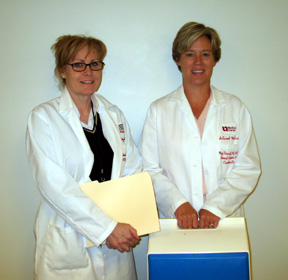 |
Kathleen Healey, left, with Mary Margaret Ursick, a nurse case manager in the department of internal medicine at UNMC. Ursick, who also participated in the AHSCT study, is one of the co-authors of the Multiple Sclerosis journal article. |
The results of a three-year study on the effects of autologous haematopoietic stem cell transplantation (AHSCT) in four patients with advanced multiple sclerosis were published recently in the journal Multiple Sclerosis.
“The findings suggest that, through the use of AHSCT, the inflammatory process of the disease is significantly decreased,” said Kathleen Healey, the first author of the report and a doctoral candidate in the department of neurological sciences at UNMC.
Multiple sclerosis is believed to be an autoimmune disorder that affects the central nervous system. Inflammation occurs when the autoimmune system attacks and damages both the myelin (the conductive coating of the nerve), as well as the nerves themselves.
Nerve transmission is altered when the myelin and nerve fibers (axons) are damaged thus causing a myriad of symptoms including difficulty walking, vision problems, numbness, bladder problems, tremors and fatigue.
Multiple sclerosis is now considered to be a “whole brain” disease. However, multiple lesions appear in different areas of the central nervous system, hence the term “multiple sclerosis or scarring.”
The UNMC study began in 1999 with four patients, three males and one female, whose disease had progressed over the previous year and were unresponsive to standard therapy.
The patients, who were recruited at UNMC and had at least a moderate amount of functional disability to begin with, received high doses of radiation and chemotherapy to attempt to abolish their “faulty” immune system.
“It’s a very aggressive and risky therapy that leaves the patient with virtually no immunity for a limited period of time,” Healey said.
Once the patient’s immune system is ablated, the “naive” stem cells siphoned from each person’s blood prior to the chemotherapy, are reintroduced, Healey said. “The hope was to completely re-grow a new immune system,” she said, “but that did not happen.”
Ruminants of the old immune system (antibodies) continued to persist in the spinal fluid of the transplanted patients, indicating that complete ablation of the immune system did not take place.
However, the results did show a profound suppression of the inflammatory response, which continued to persist up to 3 years after the transplant.
“The thought now is that we have re-programmed the immune system,” Healey said.
The procedure, while effective in stopping the inflammation, did nothing to reverse any functional disability already caused by multiple sclerosis. In fact, despite encouraging anti-inflammatory effects of the procedure, the patient’s ability to function actually worsened in three of the four participants.
But there is hope.
Healey believes that if the stem cell transplantation is done in the early stages of the disease, when the inflammatory process is at a high, damage to the myelin and axons could be averted and thus lead to less functional disability down the road.
“Endpoints of the study, MRI scans and cerebral spinal fluid, looked very good after the stem cell transplant and clearly indicated suppression of the inflammatory part of the disease,” Healey said. “That supports the notion that this therapy would be more effective in patients with early stages of multiple sclerosis.
The challenge now, Healey said, is to identify those patients whose disease is rapidly progressing early, prior to permanent damage, and then weigh the risks and benefits for the use of this aggressive treatment.
Researchers continue to monitor the long-term effects of the AHSCT procedure on the patients.
The study was part of a national trial coordinated by the Fred Hutchinson Cancer Research Center in Seattle, Wash., said Steven Pavletic, M.D., head of the Graft-versus-Host and Autoimmunity Unit, Experimental Transplantation and Immunology Branch at the National Cancer Institute in Bethesda, Md.
“UNMC was one of four centers involved,” said Dr. Pavletic, who also is the former principal investigator on this protocol in the department of medicine, section of hematology and oncology at UNMC.
“The purpose of this study,” he said, “was to show that you can use high dosages of chemotherapy and radiation safely in patients with advanced multiple sclerosis and that AHSCT has therapeutic promise.”
UNMC researchers also took the opportunity to additionally measure the function of the patients in more detail, an aspect of the trial that had not been included in the larger study.
“The whole idea of doing transplants for autoimmune disease and the collaboration required between different specialities, brings a new dimension to autologous hematopoietic stem cell transplantation,” said Dr. Pavletic. “A technology that has been developed and pioneered by the investigators in Nebraska.”
Dr. Paveltic praised UNMC for being supportive of such research and especially Healey, whom he said did an “outstanding job.”
“I am just very, very honored to have been her mentor on this,” he said.
Other researchers who contributed to the report include: the late Jinan Al-Omaishi, M.D., department of neurological sciences, UNMC; M. Patricia Leuschen, Ph.D., departments of neurological sciences and cell biology and anatomy, UNMC; Samuel Pirruccello, M.D., department of pathology and microbiology, UNMC; Mary Filipi, department of neurological sciences, UNMC; Charles Enke, M.D., department of radiation oncology, UNMC; Mary Margaret Ursick, department of internal medicine, UNMC; Francis Hahn, department of radiology, UNMC; J.D. Bowen, department of neurology, University of Washington, Seattle, Wa.; and Richard Nash, Fred Hutchinson Cancer Research Center of the University of Washington in Seattle.